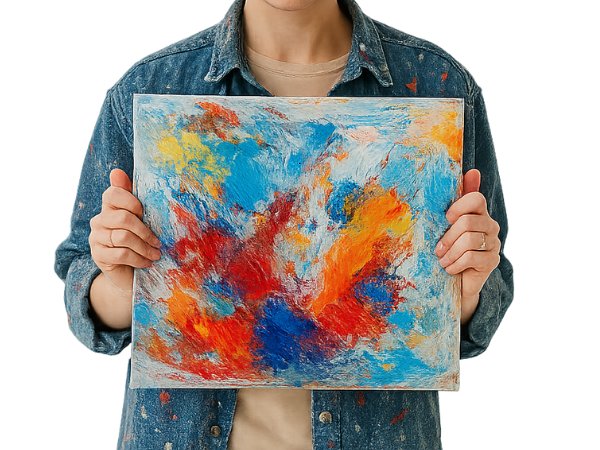“The Great Wave off Kanagawa” is one of the most famous artworks in the world. Created by Katsushika Hokusai, this print captures the power and beauty of nature.
This iconic image shows a massive wave crashing against boats near Mount Fuji. Hokusai created this artwork during Japan’s Edo period, a time of great cultural change. The print is part of a series called “Thirty-Six Views of Mount Fuji.
” It highlights not just the wave but also the relationship between people and nature. This masterpiece has inspired many artists and continues to be celebrated today. Discover why this artwork remains so significant and what it reveals about Japanese culture and art.
Introduction To The Great Wave
The Great Wave off Kanagawa, created by Katsushika Hokusai, is a famous woodblock print. It captures the power and beauty of nature. This artwork shows a giant wave towering over boats. It is part of Hokusai’s series called “Thirty-Six Views of Mount Fuji.” This print has become an icon of Japanese art. Its influence stretches far beyond Japan, inspiring many artists worldwide.
Historical Context
The Great Wave was created in the early 1830s during the Edo period in Japan. This time was marked by peace and stability under the Tokugawa shogunate. Many artists flourished during this period. Hokusai was one of them, pushing boundaries in art and culture.
Japan was opening up to the world, leading to new ideas and styles. The arrival of Western art influenced Hokusai. He blended traditional Japanese techniques with new styles. This helped create a unique visual language.
Key historical points about the Edo period:
- Stable government for over 200 years.
- Growth in trade and commerce.
- Increased interest in art and culture.
- Development of ukiyo-e, the art of woodblock printing.
The Great Wave symbolizes nature’s power. It reflects the relationship between humans and the sea. This print also connects to Japanese spirituality. It shows Mount Fuji in the background, symbolizing calm amidst chaos.
Artist Background
Katsushika Hokusai was born in 1760 in Edo, now Tokyo. He started as an artist at a young age. Hokusai experimented with many styles and techniques. He produced thousands of works, including paintings, sketches, and prints.
Hokusai became famous for his ukiyo-e prints. His art often featured landscapes, actors, and beautiful women. He was inspired by nature and everyday life. His dedication to his craft led to great innovations in printmaking.
Some facts about Hokusai:
- He adopted many names throughout his life.
- He created over 30,000 artworks.
- He influenced Western artists like Van Gogh and Monet.
- He continued to create art until his death at 88 years old.
Hokusai’s passion for art and nature shines in The Great Wave. His legacy lives on through this masterpiece, inspiring generations.
Artistic Techniques
The Great Wave off Kanagawa, created by Katsushika Hokusai, is a powerful image. It captures the beauty and fury of nature. The artistic techniques Hokusai used are essential to its impact. His methods brought this iconic piece to life. Understanding these techniques helps appreciate the artwork even more.
Woodblock Printing
Woodblock printing is a traditional Japanese art form. Hokusai mastered this technique to create The Great Wave off Kanagawa. Here’s how it works:
- Preparation: Artists carve images into woodblocks.
- Inking: They apply ink to the carved surface.
- Paper Placement: The paper is pressed onto the inked block.
- Pressing: A heavy tool presses the paper onto the block.
This method allows for multiple copies of the same image. Hokusai’s prints were often colorful and detailed. The process requires skill and patience. Each color needed a separate block. This technique made his work accessible to many people.
| Step | Description |
|---|---|
| 1 | Carve the design into wood. |
| 2 | Apply ink to the block. |
| 3 | Place paper on the block. |
| 4 | Press to transfer the image. |
Hokusai’s use of woodblock printing played a key role in his success. It allowed him to share his art far and wide.
Color And Composition
Color and composition are crucial in The Great Wave off Kanagawa. Hokusai used vibrant colors to create depth. He often used a limited color palette. This technique adds to the image’s emotional impact.
- Contrast: The deep blue of the wave contrasts with the white foam.
- Foreground and Background: The wave is in the foreground. Mount Fuji is in the background.
- Balance: The composition feels balanced despite the wave’s chaos.
The wave dominates the image. It creates a sense of movement. The placement of Mount Fuji adds stability. Hokusai’s careful arrangement of elements guides the viewer’s eye.
| Element | Role in Composition |
|---|---|
| Wave | Creates tension and movement. |
| Mount Fuji | Provides a calm and stable backdrop. |
| Sky | Enhances the dramatic effect. |
The colors and composition together tell a powerful story. Hokusai’s choices make The Great Wave off Kanagawa unforgettable.
Symbolism In The Wave
The Great Wave off Kanagawa, created by Katsushika Hokusai, is more than just a stunning image. It symbolizes the power of nature and the human condition. The wave, towering and fierce, serves as a reminder of nature’s might. This artwork captures the delicate balance between beauty and danger. The symbolism in the wave resonates deeply, reflecting themes of struggle, resilience, and cultural identity.
Nature’s Power
The Great Wave off Kanagawa emphasizes nature’s overwhelming strength. The wave appears ready to crash down, dwarfing the boats beneath it. This image evokes feelings of awe and fear. It reminds viewers of humanity’s smallness against nature’s forces. Hokusai uses vibrant colors and dynamic lines to create movement and energy. This design draws attention to the wave’s ferocity.
- The wave’s height: Represents nature’s unpredictable nature.
- The boats: Symbolize human struggle against the elements.
- The background mountains: Show stability amidst chaos.
The contrast between the wave and the boats highlights the tension in life. Hokusai’s work serves as a reminder that nature can be both beautiful and dangerous. This duality is central to the artwork’s message. It resonates with many cultures that respect the power of the sea.
Cultural Significance
The Great Wave off Kanagawa holds deep cultural meaning in Japan and beyond. It reflects the connection between people and nature. For the Japanese, the ocean is a source of life and livelihood. It also represents danger and respect. Hokusai’s wave embodies this relationship.
In addition, the artwork is part of Hokusai’s series called “Thirty-Six Views of Mount Fuji.” This series connects the mountain’s significance to Japanese culture. Mount Fuji symbolizes beauty, strength, and endurance. The wave, paired with the mountain, creates a powerful narrative.
| Symbol | Meaning |
|---|---|
| Wave | Nature’s power and unpredictability |
| Boats | Human struggle and resilience |
| Mount Fuji | Beauty and stability |
The Great Wave has inspired many artists and movements worldwide. It stands as an iconic symbol of Japanese art. Its themes of nature and humanity continue to resonate today. Hokusai’s wave encourages viewers to reflect on their relationship with the world.
Influence On Art
The Great Wave off Kanagawa, created by Katsushika Hokusai, is more than a stunning piece of art. It is a symbol of cultural exchange and influence. This iconic woodblock print has left a deep mark on various art forms. Its waves and dramatic landscape inspire artists worldwide. The impact of this artwork is vast, especially in Japanese and Western art. Understanding this influence offers insight into its lasting legacy.
Impact On Japanese Art
The Great Wave off Kanagawa has profoundly influenced Japanese art. Hokusai’s work reflects traditional Japanese aesthetics while pushing boundaries. His unique style blends nature with human emotion. This balance resonates in many Japanese artworks that followed.
Key elements of Hokusai’s influence include:
- Use of color and contrast
- Dynamic compositions
- Focus on nature and its power
Hokusai’s techniques inspired countless artists. Many adopted his method of using bold outlines and vibrant colors. His emphasis on nature’s beauty and fury is seen in:
- Ukiyo-e prints
- Paintings depicting landscapes
- Contemporary Japanese art
Artists like Hiroshige and Kuniyoshi drew inspiration from Hokusai’s vision. They explored similar themes of nature and human interaction. The Great Wave remains a reference point in Japanese art education.
Western Art Movements
The Great Wave off Kanagawa reached beyond Japan. It influenced many Western art movements. Its arrival in Europe coincided with a growing interest in Japanese art. Artists were captivated by Hokusai’s unique style. This sparked a new appreciation for Eastern aesthetics.
Key impacts on Western art include:
- Impressionism: Artists like Monet admired Hokusai’s use of light and color.
- Post-Impressionism: Van Gogh was inspired by the wave’s movement.
- Art Nouveau: The flowing lines and nature motifs echoed Hokusai’s designs.
Many Western artists incorporated Hokusai’s elements into their works. They embraced the fusion of nature and abstraction. The Great Wave played a crucial role in shaping modern art concepts.
Reception Through The Ages
The Great Wave off Kanagawa, created by Katsushika Hokusai, is one of the most recognized works of art in the world. This woodblock print depicts a giant wave threatening boats near Mount Fuji. Its beauty and power have captured hearts for centuries. Understanding its reception through the ages reveals how this artwork became a symbol of Japanese culture and artistry.
Initial Reception
When The Great Wave first appeared in the early 1830s, reactions were mixed. Some viewers admired Hokusai’s unique style. Others found it challenging. The artwork was part of a series titled “Thirty-Six Views of Mount Fuji.” This series aimed to highlight the beauty of Japan’s landscape.
Key points about its initial reception:
- Art critics were divided.
- Some praised Hokusai’s technique.
- Others felt the wave was too dramatic.
The print gained popularity in Japan but was not widely known outside the country. Hokusai’s use of color and form was innovative. He blended traditional Japanese techniques with Western influences. This was new at the time. The print’s unique composition caught attention.
The initial reception can be summarized in the following table:
| Aspect | Reaction |
|---|---|
| Artistic Style | Praise for uniqueness |
| Emotional Impact | Some found it overwhelming |
| Popularity | Grew gradually in Japan |
Modern Appreciation
The Great Wave off Kanagawa has gained immense popularity in modern times. It is celebrated worldwide. Today, it is seen as a masterpiece of Japanese art. Many art historians study Hokusai’s work for its cultural significance.
Key factors in modern appreciation include:
- Widely reproduced in various media.
- Featured in art exhibitions across the globe.
- Inspiration for contemporary artists.
Many people recognize it without knowing its title or artist. It appears in books, fashion, and even advertisements. The wave symbolizes strength and beauty. It resonates with many cultures. The emotional depth of the print draws viewers in.
Modern reactions can be summarized in this table:
| Aspect | Reaction |
|---|---|
| Global Recognition | Iconic status achieved |
| Cultural Impact | Influences various art forms |
| Merchandising | Used in fashion and decor |
The Great Wave continues to inspire. It remains a beloved piece of art, bridging cultures and time.
The Great Wave In Popular Culture
The Great Wave off Kanagawa, created by Katsushika Hokusai, is one of the most famous artworks in the world. This iconic woodblock print captures the power and beauty of nature. Its influence extends far beyond the art world. The Great Wave has made significant impacts in popular culture. Its striking image appears in various forms, from movies to merchandise. This blog explores how The Great Wave has inspired and transformed modern media and products.
References In Media
The Great Wave has appeared in many forms of media. Its dramatic depiction of the ocean resonates with many creators. Here are some notable references:
- Film: The Great Wave inspired scenes in animated movies. Directors often use its imagery to show nature’s strength.
- Music: Album covers feature The Great Wave. Artists use it to symbolize power and emotion.
- Literature: Books and poems reference the artwork. Writers draw parallels between the wave and human experiences.
Its impact even reaches video games. Here is a table of popular games featuring The Great Wave:
| Game Title | Year Released | Reference Type |
|---|---|---|
| Okami | 2006 | Visual Art |
| Sea of Thieves | 2018 | Game Artwork |
| Borderlands 3 | 2019 | In-Game Poster |
These references show how The Great Wave continues to inspire and connect with audiences worldwide.
Merchandising And Adaptations
The Great Wave off Kanagawa has also become a popular item for merchandising. Its image is found on various products. Here are some common items:
- Posters and Prints: Many people hang replicas in their homes.
- Clothing: T-shirts and scarves feature the artwork.
- Home Decor: Items like pillows and wall art showcase The Great Wave.
Adaptations of the artwork also thrive in different formats. Artists create modern interpretations, blending styles and themes. Here are some examples:
- Digital Art: Artists use technology to reinterpret The Great Wave.
- Street Art: Murals use Hokusai’s wave to convey messages about climate change.
- Fashion Collaborations: Designers incorporate the wave in their collections.
The Great Wave remains a powerful symbol. It connects with people in various ways through merchandise and adaptations.
Conclusion
The Great Wave off Kanagawa remains a powerful symbol of nature. Hokusai captured the sea’s beauty and danger. This artwork connects us to Japan’s rich culture. It inspires many artists today. The wave teaches us about resilience and strength. Its impact reaches far beyond art.
People across the world admire its beauty. Understanding this piece deepens our appreciation for Hokusai’s genius. Explore more about this masterpiece and feel its power. Discover how art can reflect our own experiences with nature.




